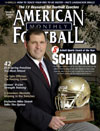AMERICAN FOOTBALL MONTHLY THE #1 RESOURCE FOR FOOTBALL COACHES
Article CategoriesAFM Magazine
|
Bunch it Up - Part 2 of 2The Bunch Package offers a wide variety of plays, advantages and mismatchesby: Gunter Brewer Passing Game Coordinator, Oklahoma State University © More from this issue In last month's issue I discussed the philosophy and strategy of our Bunch Package. Included in the article was our Boom-Boom Screen, Green Bay series, and the Alley Toss play. In this segment we'll concnetrate on two additional plays: the Weak Side Run Counter and the Play Action Sting Route. Weak Side Run Counter (See Diagrams 1 & 2) This is an off-tackle run to the open-end side with veer / gap blocking scheme at the point of attack and counter backfield action. The Backside Guard will pull for the end man of the line and either kick or cut. The FB will follow the Guard and lead on the playside LB.
|
Copyright 2025, AmericanFootballMonthly.com All Rights Reserved | |||||||||||||






